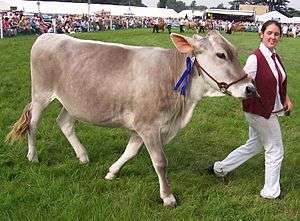Brown Swiss

Brown Swiss is a North American breed of dairy cattle. It derives from the Alpine Braunvieh. After the Holstein Friesian, it has the second-highest annual milk yield, over 9,000 kg (20,000 lb) per annum.[1] The milk contains on average 4% butterfat and 3.5% protein, making their milk excellent for production of cheese. The Brown Swiss is known for a long gestation period, immense size, large furry ears, and an extremely docile temperament. Regardless, the Brown Swiss is quite a resilient breed of cattle; they are hardy and capable of subsisting with little care or feed.
Origins
The Brown Swiss originated on the slopes of the Alps in Switzerland; because they were bred in this harsh climate, they are resistant to the heat, cold and many other common cattle problems. In 1949, animal scientist Hilton M. Briggs postulated the original population of cattle in the European Alps were improved with Pinzgauer blood. The hypothesis was based on an incomplete knowledge of cattle color genetics and history.[2] Greater knowledge of the bovine genome has disproved that conjecture.
The conventional, American breed known as Brown Swiss is actually quite different from the original Schwyzer Braunvieh cattle bred in Switzerland around the end of the 17th and 18th centuries.[3] The first cows and bulls of the breed that became later known as Brown Swiss were imported from Switzerland into the United States by Henry M. Clark in the winter of 1869—William Tell, the bull, and seven cows called Zurich, Lucerne, Gretchen, Brinlie, Lissa, Christine, and Geneva.[4] 25 bulls and 140 cows total were imported from Switzerland to America.[5] While not an uncommon breed to find as the basis of a pure-blooded herd, the Swiss is also commonly encountered as a pet or token example on larger farms with mostly Holstein or Jersey cattle.
Characteristics
Normally large with large, fuzzy ears.[6] They are also very resistant to heat and cold, and have a docile and kind nature.
Milk of the Brown Swiss is unique as well, having longer-chain fatty acids than other popular dairy breeds and smaller fat globules in the cream; this difference means that cream rises much more slowly in milk from Brown Swiss cows. [7] This difference, and the ratio of protein to fat in the milk, is ideal for cheesemaking.[8]
References
- ↑ Brown Swiss Association
- ↑ Schmutz, Sheila (August 16, 2009), Genetics of Coat Color Patterns in Cattle.
- ↑ "Archived copy". Archived from the original on 2011-07-15. Retrieved 2011-06-14.
- ↑ "Archived copy" (PDF). Archived from the original (PDF) on 2010-10-15. Retrieved 2010-02-20.
- ↑ http://www.brownswissusa.com/history.asp
- ↑ https://animalcorner.co.uk/cow-breeds/
- ↑ https://www.researchgate.net/publication/248332914_Milk_composition_of_Holstein_Jersey_and_Brown_Swiss_cows_in_response_to_increasing_levels_of_dietary_fat
- ↑ http://www.adadc.com/dairy-dictionary.html
External links
| Wikimedia Commons has media related to Brown Swiss. |